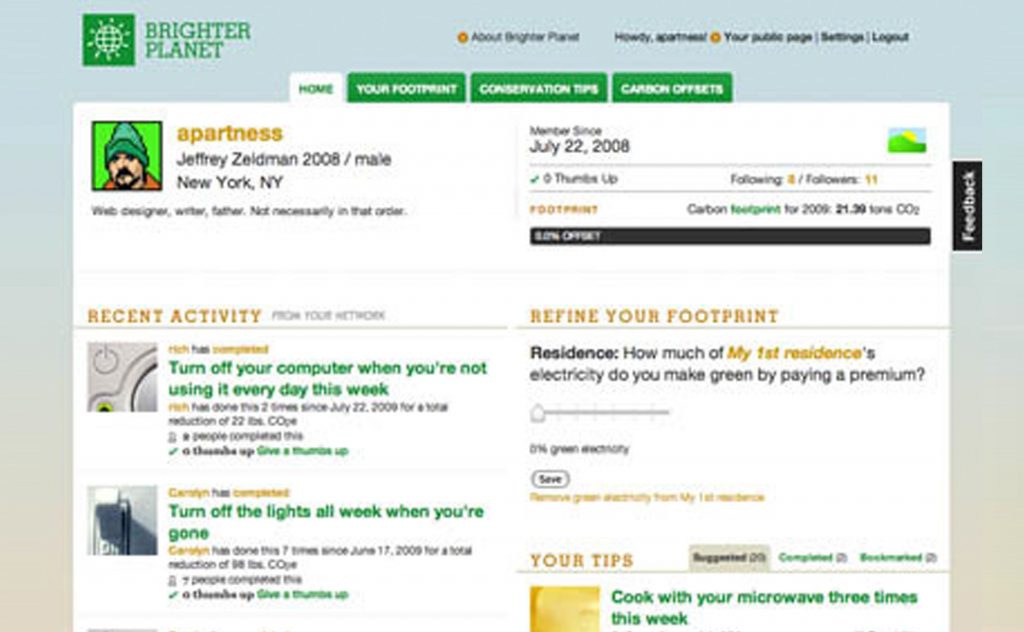A social network founded on settled science: The story of Brighter Planet
Helping people become more eco-conscious without making them feel guilty: that was the goal of the social network we designed for Brighter Planet, which went into public beta on 16 July 2009 and ran for seven years.
To define the user experience, first define the user
Like all social networks, this one was about about community: building, sharing, and fun. And like all social networks, it served all kinds of people. In this case, it served anyone on planet Earth with an internet connection.
How do you design a user experience for everybody? The answer is, you dont. You design for key types of people, letting their energy and activity evangelize and build the network. (Flickr.com, for example, appeals to everybody, but was initially designed for casual amateur photographers and passionate hobbyists. Facebook was originally for college students. Twitter was an internal communications tool that initially attracted an early adopting audience of web nerds, and now mainly appeals to journalists, celebrities, and publicists.)
Working collaboratively with Brighter Planets marketing and development leads, we identified two key user groups: passionately committed environmentalists (deep greens), and ordinary folks who cared about the environment but werent going to ditch their cars or switch off their air conditioners any time soon.
The social network had to work for both groups. It had to be profound enough to satisfy the deep greens, yet fun and light enough (not to mention customizable and respectful of privacy) to appeal to the casual environmentalist.
Our design process, beginning with detailed stakeholder and user interviews, led to the conclusion that casual environmentalists (moms, professionals, small business owners) would work best as our primary target. A site that worked for them would work for everyoneincluding deep greens. Whereas a site tailored mainly to deep greens would very likely perplex and turn off casual environmentalists.
Science and Soul
At the core of the new social media network was a tool that let users calculate an accurate carbon footprint for their family or business. They could then offset this footprint by following conservation tips or purchasing carbon offsets. We simplified the experience of choosing carbon footprint components and entering data, and integrated the carbon profiler into the entire site experience. This enabled a casual environmentalist to add to her profile as the opportunity arose, while giving a deep green the ability to spend hours fine-tuning her footprint.
If an in-depth, accurate carbon profiler was the heart of the network, conservation tips were its social soul. We designed them to be easy to write, easy to browse, easy to rate; they should be as quick and easy as dashing off a Yelp or Foursquare review. Members could follow other members, give them a thumbs up for completing a conservation tip (such as installing a low-flow shower head in one bathroom), and, of course, obsessively edit their Profiles.
In parallel with the user experience exploration, we developed a light content strategy that supported the sites tone and goals. After the network was envisioned and refined in exquisite wireframe detail, we crafted a low-key look and feel designed to subtly convey ecological themes, add an element of playfulness, and wear well over the long haul. Its not a knock-you-in-the-face look and feel, but a design to be lived in, for years to come. And for seven years, folks did just that.
Zeldmans team worked tirelessly to understand Brighter Planets needs and those of our customers. They were instrumental in helping to shape our concept, voice and audience, and as a result, crafted a magnificent architecture and design.
Adam Rubin, CTO, Brighter Planet
Climate Change You Can Believe In
Brighter Planet helped people take control of their environmental footprint: measure their climate impact, discover simple ways to reduce it, track their progress, and share their experiences with other people who who want to make a difference. We were proud to play a part in bringing Brighter Planets vision to life.
But like most startup businesses, Brighter Planet was a gamble and folded after seven inspiring years. You can no longer experience the site we created, but you can read about it here.
Our responsibilities on this project
Strategy; research; user experience; information architecture; interface design; front-end development.

